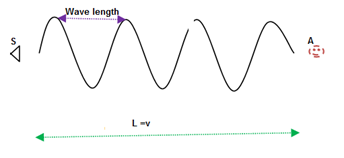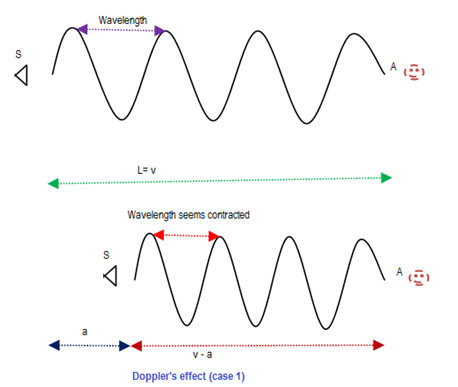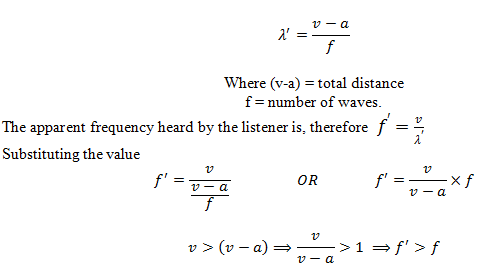Question 9: What is Doppler’s effect? Derive expressions for the frequencies heard,
(1) When the sounding source approaching a stationary listener.
(2) When the listener moves towards a stationary sounding source.
ANSWER
The apparent change in the frequency of sound caused by the relative motion of either the source of sound or listener or both is called Doppler’s effect.

Suppose a source of sound, named ‘S’, is emitting waves traveling with velocity ‘v’ towards the listener ‘A’. See figure. If
- The number of waves emitted in one second = frequency = f
- Wavelength of the wave = λ
- Distance between ‘S’ and ‘A’ = L
- As L = vt and if we put t = 1, then, L = v
As the time is 1 second, therefore, ‘f’ number of waves are compressed in this distance ‘v’. So, Wavelength = λ = v/f ⇒ f = v/λ
(In the figure, there are 3 wavelengths in distance v).
Now, let’s consider the given cases.
Case1: Source approaches a stationary listener

Consider the diagram. Suppose ‘S’ is the source of sound, ‘A’ is the listener. Let ‘v’ is the speed of emitted sound wave and ‘f’ is its frequency. Further, let λ is the wavelength of the wave,and the sounding source approaches the listener with a speed ‘a’.
Let at some instant, the source emits the first wave which covers a distance ‘v’ and reaches the listener in one second. (s = vt ⇒ s = v; when t = 1).
At the end of one second, the source covers a distance ‘a’, the speed of the source. (Again s = at ⇒ s = a; when t = 1). Now, let the source emits last wave.’f’ number of waves are now compressed in a smaller distance of (v – a). Same number of waves compressed in a smaller distance means an apparent contraction(tightening) of wavelength. So the apparent wave length λ‘ is,

Therefore, the apparent frequency increases when the source is approaching a stationary listener. Consequently,the pitch of the sound also increases.
Case2: The listener moves towards a stationary sounding source
Let the listener ‘L’ is moving with a speed ‘b’ towards the stationary sounding source ‘S’. The sound waves and the listener approach one another. Their velocities will be added.
If we add the speed of sound to the speed of the listener we shall get the case when the sound waves are moving with a velocity (v + b) and both source and listener are at rest. So the speed of sound relative to the listener is (v + b)and hence the listener will be receiving more waves per second. The apparent frequency of the waves would be f“.
Relative velocity = v + b
Relative frequency = f“

The relative frequency is, therefore, given by


So the apparent frequency will increase. (Pitch of the sound will also increase).

Pingback:Comprehensive Questions on Waves … msa – msa
Pingback:multiple-choice-questions-on-waves-chapter-8-physics-11 – msa
Pingback:organ-pipes-and-harmonics – msa
Pingback:beats-production – msa
Pingback:index-cqs8-p11